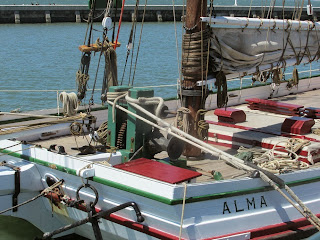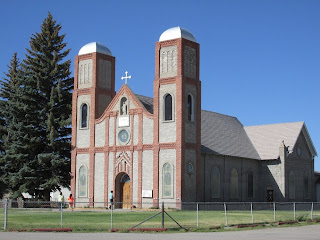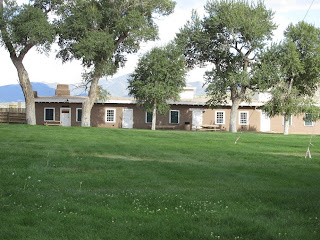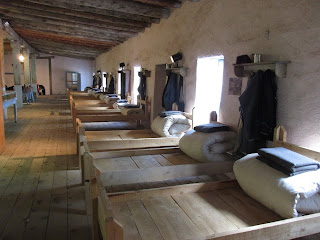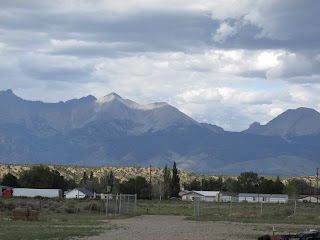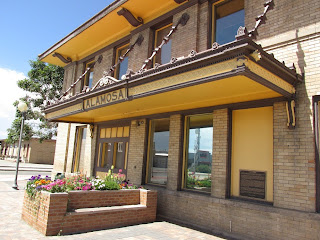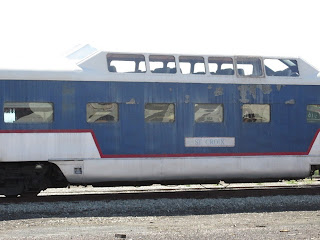 |
| Sign along the old Chisholm Trail in Round Rock TX |
The peak years of the great cattle drives were the twenty years between 1866 and 1886. That being said, Texans were known to drive cattle eastward toward New Orleans as early as 1836. In 1853 there was a successful cattle drive all the way from St. Louis to the port of San Francisco which seems incredible.
After the Civil war the potential for profit was so great that a good deal of investment money came from overseas, Scottish and English investors being the top two sources of capital. The first post war rail head destination for Texas cattle was Abilene Kansas. The rail heads continued to build westward to Wichita, Dodge City and even to Las Vegas New Mexico just 60 miles east of Santa Fe.
Today, tourists visiting the west and southwest can see many reminders of the great cattle trails.
 |
| Surviving structure along the trail in Old Round Rock |
The Chisholm Trail ran from southeastern Texas near the San Antonio area north past the towns of Austin Texas, Round Rock, Salado, Denton and across the Red River at Red River Station and into Indian Territory past present day Duncan Oklahoma on it's journey to the rail head at Abilene Kansas. The trail followed closely to today's Interstate 35. The Chisholm trail was named after Jesse Chisholm who owned trading posts in western Oklahoma before the Civil War.
The Chisholm Trail was most active from 1867 to 1871. By 1885 barbed wire erected by settlers flooding into the region essentially closed the trail permanently. During it's active years more than five million cattle and a million mustangs traveled over the Chisholm Trail.
There are several reminders and historical markers to be seen today along the old path of the trail. The Chisholm Trail Crossing Park in Round Rock Texas reminds visitors of the city’s history. At the low water crossing there is a plaque commemorating the crossing where there is also the rock from which Round Rock took it's name. It's said that old wagon ruts can still be seen at the site of the crossing.
 |
| Original Fort Reno structure along the Great Western Trail |
Visit Duncan Oklahoma and take a drive east to where a general store servicing the drovers once stood. There you'll see an historical marker and if you explore real good you'll see visible ruts in the ground from the millions of cattle hooves that passed this site heading north. You'll also want to visit the Chisholm Trail heritage Center in Duncan. Here you'll be treated to a multi-sensory exploration of the Chisholm Trail as well as the story of early settlement in the southern plains. Duncan Oklahoma is located about 80 miles southwest of Oklahoma City and about 64 miles northeast of Wichita Falls Texas.
Doan's Crossing on the Great Western Trail
The Great Western Trail began in the area south and southwest of San Antonio Texas down to the Rio Grande and, with it's many side routes, actually reached as far north as the Canadian border. The Great Western Trail or Texas Trail is considered the longest of all the old west cattle trails.
There is a spot along the Red River dividing Texas from Oklahoma called Doan's Crossing which was where cattle driven along the Great Western Trail, sometimes referred to as the Western Trail and Texas Trail, crossed on their way north to Dodge City Kansas during the 1870's. An interesting side note is that Jonathan Doan who established the trading post at the crossing became the first person to permanently settle in Wilbarger County Texas.
 |
| Chuckwagon exhibit at NM History Museum |
Doan's Crossing is located about 13 miles northeast of Vernon Texas and about 60 miles northwest of Wichita Falls.
In 2003 a project was launched to mark the entire Great Western Trail with a cement post place every six miles. The initial plan was to mark the trail from the Rio Grande to Ogallala, Nebraska.
The Great Western Trail also passed historic Fort Reno Oklahoma which was originally built while in Indian Territory. This is a stop you want to make while driving through Oklahoma on Interstate 40 west of Oklahoma City. Tour the original buildings of the fort as well as it's museum with many fine artifacts. Fort Reno is located about 27 miles west of Oklahoma City and just north of the Interstate.
A few additional Western Trips articles you may enjoy are on the links below...
American Cowboy Gear and Attire
Texas Ranching
Famous Texas Rancher George Littlefield House / Austin TX
A Visit to Doan's Crossing on the Red River
 |
| Las Vegas NM along the Goodnight-Loving Trail |
Among the historic accomplishments of Charles Goodnight was when he created the Goodnight-Loving Trail from Fort Belknap Texas into New Mexico in 1867. The Goodnight-Loving Trail would eventually run from Fort Belknap (near present day Newcastle Texas) west into New Mexico, then up to Denver Colorado and later further north into Cheyenne Wyoming.
Goodnight did this with the knowledge that Indian trouble could commence at any time and it was said that at one point he drove the herd some eighty miles without water. In fact, Oliver Loving, Goodnight's partner in 1867, died while wounded and trying to hold off Indians on his way to deliver beef to Fort Sumner New Mexico. This 2,000 mile trail to Fort Sumner and then north into Colorado would soon be named the Goodnight-Loving Trail.
The journey and terrain by all accounts was very tough but in making it Goodnight proved to all that cattle could be driven over rugged regions that were considered by many to be a cattleman's graveyard. The route left Fort Belknap and followed the old Butterfield Stage Line route to the Pecos River. Then it was up the Pecos to near Las Vegas New Mexico and further northward past Raton Pass and into Colorado.
The Goodnight-Loving Trail would pass by Raton New Mexico and enter Colorado through Raton Pass where a toll keeper was charging about ten cents per head for access through the pass. It wasn't long before Charles Goodnight found a slightly alternate route through the pass avoiding this fee. Raton Pass would later be the entryway into New Mexico from Colorado by the Atchison Topeka & Santa Fe Railroad.
 |
| Goodnight Ranch House, Goodnight TX |
Another site commemorating Goodnight's ranching achievements is a statue of him outside of the fascinating Panhandle-Plains Historical Museum in Canyon Texas, about a 15 minute drive south of Amarillo along Interstate 27. If you have not visited this museum I would highly recommend it to anyone traveling through the Amarillo Texas area. There is an amazing amount of historic artifacts plus an excellent historic research center.
To see where the Goodnight-Loving Trail ran along the Pecos River in New Mexico, stop at Fort Sumner which has an amazing museum and is the site where Billy the Kid is buried. Fort Sumner is located about 45 miles south of Santa Rosa New Mexico. Santa Rosa is directly on Interstate 40 about 114 miles east of Albuquerque.
Three excellent books on the subject of ranchers, cowboys and cattle drives include The Cattle Kings by author Lewis Atherton...The Western: The Greatest Texas Cattle Trail, 1874 - 1886 by authors Gary Kraisinger and Margaret Kraisinger...Charles Goodnight: Father of the Texas Panhandle by author William T. Hagan.
(Article and photos copyright 2013 Western Trips)



